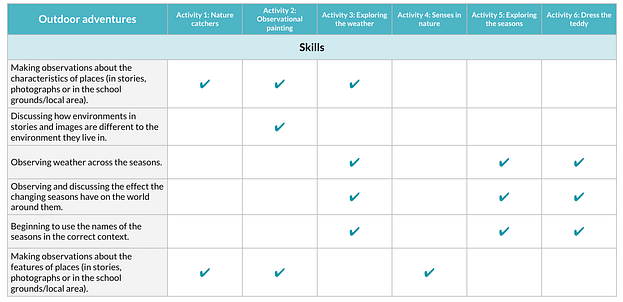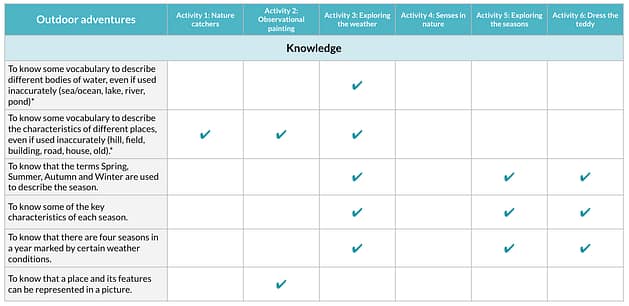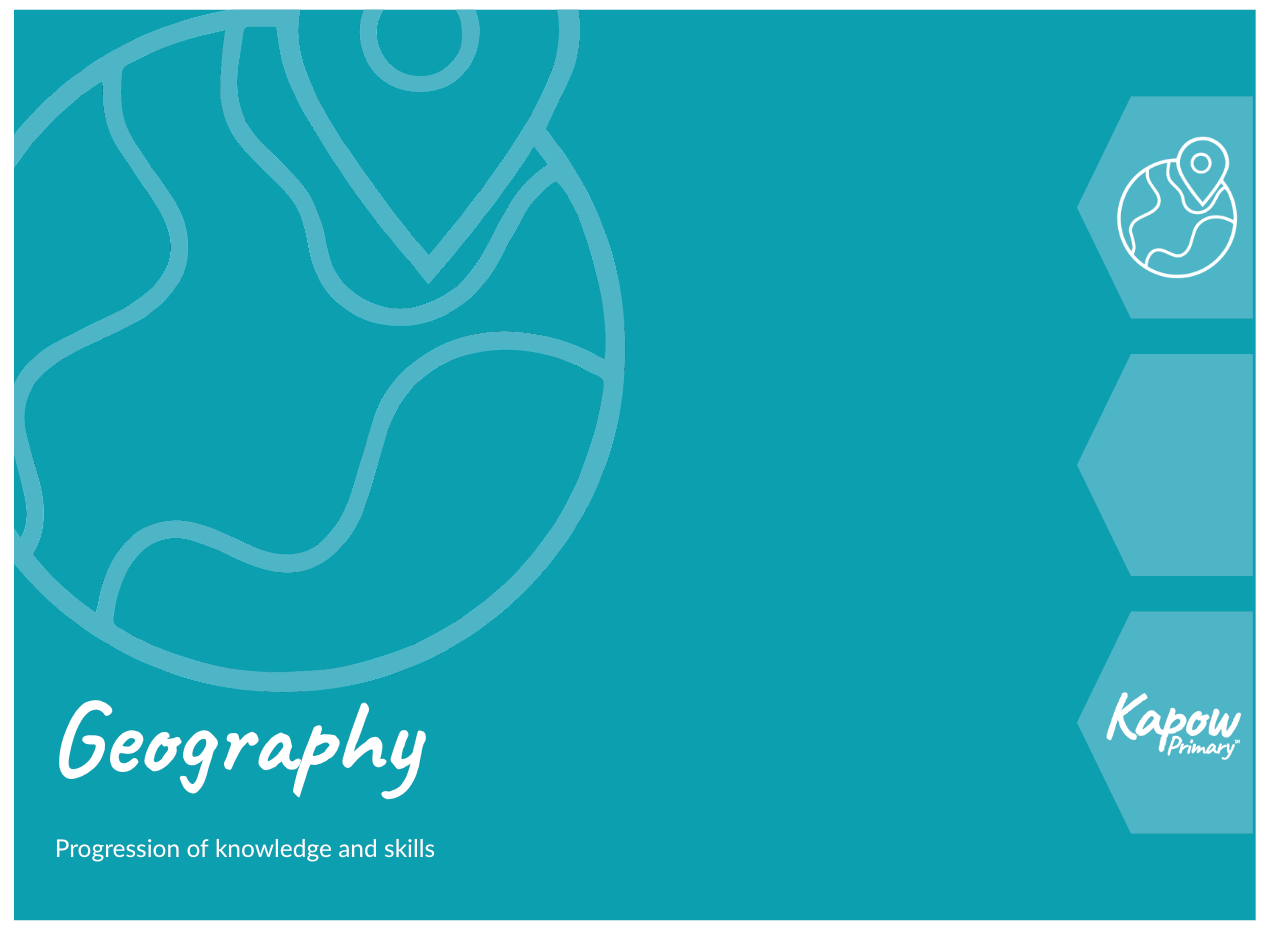Outdoor adventures
Using the senses to explore and describe the natural world around them whilst outside; understanding the effect of the changing seasons.
The Curriculum and Assessment Review final report has been released. We’re reviewing the recommendations and planning for future updates. Learn more
EYFS outcomes
Development matters
- Explore the natural world around them.
- Describe what they see, hear and feel whilst outside.
- Understand the effect of changing seasons on the natural world around them.
See Development Matters (non-statutory curriculum guidance).
Early learning goals
ELG: Understanding the World – People, Culture and Communities
- Describe their immediate environment using knowledge from observation, discussion, stories, non-fiction texts and maps.
ELG: Understanding the World – The Natural World
- Explore the natural world around them, making observations and drawing pictures of animals and plants.
- Understand some important processes and changes in the natural world around them, including the seasons and changing states of matter.
See Statutory framework for the early years foundation stage.
Choose your lesson
Activity 1: Nature catchers
Activity 2: Observational painting
Activity 3: Exploring the weather
Activity 4: Senses in nature
Activity 5: Exploring the seasons
Activity 6: Dress the teddy
Optional sustainability lesson: How can we welcome animals on the school grounds?
Key skills
Key knowledge
Teacher guidance
Using the activities
The activities are designed to support Reception teachers in targeting Development matters statements and laying the foundations for pupils’ further geography learning. In this unit, the Development matters statements ‘Explore the natural world around them’, ‘Describe what they see, hear and feel whilst outside’ and ‘Understand the effect of changing seasons on the natural world around them’ are broken down into their core skill and knowledge components, linked to the Kapow Primary Geography curriculum in KS1 and KS2.
Refer to the skills and knowledge grid below to choose which activities to use with your class.
Activities can be delivered in any order and at any time of the year to suit your curriculum, specific topic, or cohort.



Activities can be organised to suit your setting. Options include:
- Using them as a whole-class lesson.
- Introducing activities to the whole class before setting them up as part of the enhanced provision.
- Allowing children to access the activities independently as part of the enhanced provision.
Further guidance
Ideas for teacher-led input
Read stories about exploring nature using the senses.
Go for a walk around the local area, using all the senses to describe what they experience and the characteristics of what they can see (hill, field, building, road, house, etc.)
Explore Google Earth and use the opportunity to virtually visit different landscapes around the globe and compare and contrast these with the local environment.
Hold some mindful meditation or nature-bathing sessions in your outdoor environment.
Parktake in some cloud gazing and use communication and language skills to describe what can be seen, as well as learning where clouds come from and what they do.
Support pupils in naming the trees and plants that can be found on your school grounds. Collect leaves to make rubbings, leaf necklaces or to use in mud kitchen play.
Take the pupils on a seasonal walk every few months. Look for changes in the environment and discuss findings.
Ideas for topic links
The Senses: Introduce the idea of the senses and how to use these to explore the natural environment.
The Seasons: Compare how the natural environment and the local area changes throughout each of the seasons. What does it look like? How does the weather change? Does it smell differently? Do the sounds change?
Our Local Area/Where We Live: Use the opportunity to explore the features of your local area and identify familiar landmarks and place names.
Around the World: Compare different countries and cultures around the world, exploring similarities and differences.
Minibeasts: Study the minibeasts present in the natural environment, learning their names and features. Create observational drawings, minibeast hotels and go on a ‘bug hunt’.
Animals and their Habitats: Link the natural environment with animals and their habitats, exploring the similarities and differences between animals that live in this country and other environments around the world.
Recommended texts
‘Rosie’s Walk’ by Pat Hutchins (this story works as an excellent prompt for pupils to write their own story describing a simple journey and characteristics of their surroundings).
‘Let’s Go for a Walk’ by Ranger Hamza.
‘We’re Going on a Leaf Hunt’ by Steve Metzger.
‘A Walk in the Woods – A Changing Seasons Story’ by Flora Martyn.
‘All the Water in the World’ by George Ella Lyon.
‘The Tiny Seed’ by Eric Carle.
Continuous provision ideas:
Where possible, provide free-flow access to the outdoor area so that pupils can explore the natural environment in all seasons and weathers. If free-flow is not possible, then make sure that your timetable allows purposeful playtime outside at least once per day (in addition to school playtimes).
Consider setting up a mud kitchen if you do not have one already. Mud kitchens do not need to be large and you can easily get started with a couple of upturned milk crates with a plank of wood on the top. Add some pans, spoons and containers, along with natural resources and access to soil/mud and water.
Place a globe in your continuous provision and encourage investigation and questions. Can the children recognise the difference between the land and the oceans? Can they find the UK on the globe? This can be a useful reference point when children go on holiday or you are studying other countries/cultures.
Use Google Maps/Google Earth on the interactive whiteboard as part of your enhanced provision and/or as a mini circle time activity before lunch/playtime, etc. Identify familiar geographical locations such as the school, as well as where the children live.
Include non-fiction books that explore animals, minibeasts and different countries in the reading area.
Encourage vocabulary to describe different bodies of water as part of play: sea, ocean, lake, river, pond, stream, etc.
Encourage vocabulary to describe the characteristics of different places as part of play: hill, field, building, road, house, old, new, tall, etc.
Ensure that your small world, water, sand and outdoor areas contain the resources needed for pupils to build their own landscapes and habitats.
Wider experiences
Visitor: Explore opportunities for in-school visits from local and national organisations such as the RSPB, the National Trust and the RHS.
Event: Visit a local nature space (park, moor, nature reserve, woodland) and use the senses to explore. Take magnifying glasses, bug pots, containers and nets to allow pupils to observe and gather natural objects and minibeasts.
Related content
Unit resources

Geography: Progression of skills and knowledge
Gives an overview of the skills and knowledge covered in each phase and strand the Geography curriculum.
